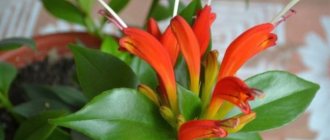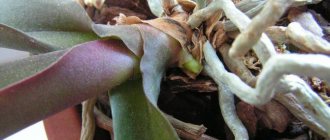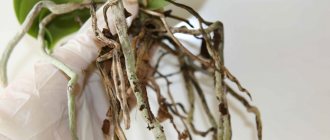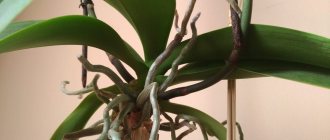The importance of healthy roots for a plant
Healthy orchid roots can absorb moisture not only when watering, but also from the air . Since in its homeland in tropical forests, the beautiful orchid can grow not only on trees, but also on stones, where they are bare and absorb moisture from the air, oversaturated with tropical moisture.
IMPORTANT! Only healthy roots can deliver moisture from the tips to the leaf cells.
Below we describe what healthy roots look like.
Varieties of white plaque on orchid roots
Orchid growers often notice whitish dots, spots, mold deposits or tiny balls on the plant and even on the substrate. What causes these phenomena, how dangerous are they and how to get rid of them?
| Varieties of white plaque | Causes | Consequences and methods of combating |
| White dots on orchid roots | Spots appear on the root system, surface and depth of the substrate due to the use of hard water containing a large amount of salts for irrigation. Over time, they accumulate in the substrate and change its composition. | Due to soil salinity, air flow is disrupted. Filtered water should be used for irrigation. Change the soil. |
| White balls | They have a spherical or irregular shape and a size of up to 2–3 cm. On the roots of orchids, white balls are the result of the interlacing of filamentous processes of the mycelium. They can capture most of the substrate and roots of the orchid. | The mycelium deprives the plant of nutrients and can cause the death of the root system. |
| Mold | On the roots of orchids, white fluff is a consequence of the proliferation of fungi and their spread in the soil. | In order to prevent damage to the orchid, when caring for it, it is important not to allow the substrate to become waterlogged, especially when the temperature drops to +200 C. |
What kind of roots should a healthy orchid have? Photo of the root system
As you can see in the photo, healthy orchid roots should have :
- Growing tip.
- Have a light green velamen color.
- Be elastic and hold its shape when pressed with two fingers.
- Dark and having a putrid odor, this is a sign that the root system is unhealthy and requires resuscitation.
They must completely occupy the container in which the flower grows. This can be easily checked by gently moving the orchid. If it is tightly secured in the pot, then the roots are enough to hold it. If the flower does not hold tightly, then a small fraction of them remains and you will have to increase them.
If the root system has grown greatly and is protruding from the container where the flower is planted, then it simply needs to increase the living space by transplanting it into a larger container.
IMPORTANT! You need to purchase a healthy flower, since when transplanted, even with all the precautions, it loses a certain part of the root mass, and, consequently, some of the leaves.
Appearance of a diseased root system
The roots of the orchid may undergo pathological changes. Under such circumstances, the roots of the orchid change their appearance and color. Most often, orchid roots are damaged as a result of putrefactive changes. This process occurs especially often in the autumn-winter period, which is associated with a decrease in ambient temperature and a decrease in exposure to sunlight. Changing conditions can cause a houseplant to go dormant.
External changes may not be noticeable, the leaves will retain their density and absolutely natural color. At this stage, the root system stops absorbing moisture, and the water accumulated in the planting container becomes a factor causing rapid rotting.
When the roots of an orchid die as a result of rotting, the gardener still has a chance to save the indoor plant by performing a number of fairly simple and accessible measures, including pruning.
Saving an orchid without roots
A plant that, as a result of the rotting process, has partially or completely lost its root system is subjected to pruning. The standard orchid rescue system involves the step-by-step implementation of the following measures:
- remove the indoor plant from the planting flower pot;
- thoroughly rinse the remaining root system, which will increase the plant’s chances of survival;
- thoroughly dry the plant’s root system in warm air and carefully inspect it;
- healthy areas of the root system have a dense and elastic structure, while the rotted part is largely soft and, when pressed, causes the release of liquid;
- remove all dead and diseased areas of the root system, and then dry the pruning areas and treat them with activated carbon.
Further measures and methods of saving an indoor orchid will entirely depend on the type of plant, as well as the volume of damaged root mass. As a rule, while maintaining a significant volume of the root system, additional illumination with phytolamps and planting in expanded clay with sphagnum moss are used.
Features of roots
The tropical beauty has its own structural features of the root system. And you should know about them in order to properly care for your pet so as not to lead to its death.
Structure
The epiphytic type consists of:
- Apical root tip;
- Conductive thread of the root;
- Velamena;
- Root parenchyla.
All this helps the orchid absorb moisture from the humid atmosphere.
Features of caring for orchid roots
Caring for orchids is not easy even for experienced specialists who know how to properly treat the roots, taking into account the capriciousness of the plant and its needs. It is necessary to adhere to the rules of hygiene: both the soil and containers and tools must be washed and treated with a solution of potassium permanganate or appropriate chemicals.
Cutting tools must be sharp so as not to injure the roots or other parts of the plant. And the most important feature of caring for an orchid is putting your soul into the work - all manipulations are carried out carefully, carefully, and affectionately.
The root system of any plant is its “heart”. This statement is especially true for orchids. These beauties will respond to their owners' care with beautiful flowering only if their roots are in perfect order.
How does a plant's specific lifestyle affect its roots?
An orchid in its native tropics leads a specific lifestyle , and the root mass differs from other roots:
- Since most orchid plants are epiphytes, they need roots to attach tightly to stones or tree trunks on which they will subsequently grow;
- Since the plant does not need soil in the usual sense, they get their nutrition from moist air . In this case, part of the roots burrows into the litter of fallen leaves, where they take nutrients for themselves.
IMPORTANT! That part of the roots that remains on the surface participates in photosynthesis at the level of leaf blades.
Photosynthesis
As already mentioned, roots participate in photosynthesis . Therefore, experienced gardeners plant orchids in transparent containers, and instead of a purchased substrate, they plant them in the bark, since in addition to sunlight, photosynthesis requires oxygen, which enters through the loose bark into the middle of the pot.
Moisture production process
Water enters the plant through the osmotic mechanism, which is the molecular process by which water moves from the aquatic environment into the plant. This entire process occurs in the upper layers of the root mass, called the rhizoderm .
This department of the root structure is responsible for the delivery of moisture from the environment to the conducting rod. From the rhizoderm, water enters the conductor, which actually transfers moisture further into the plant. For this, it is important for the plant to have a healthy root system.
Features of the root system of orchid plants
There are three large ecological groups of plants in the orchid family:
- epiphytic, which settle on tree trunks;
- lithophytes, which are attached to mossy stones;
- terrestrial, growing in soil.
Depending on the substrate on which particular orchids grow, the structure of their roots will have its own characteristics:
| Epiphyte roots | Lithophyte roots | Roots of terrestrial species |
| Adapted to life in the air. They grow to the woody substrate, but are not able to absorb nutrients or water from it. They capture rain and atmospheric moisture with dissolved mineral salts. | They grow on rocky substrate covered with moss. Like epiphytic roots, they take water and nutrition from rain streams and atmospheric condensate. | Adapted to life in soil. They absorb water and nutrient solutions using root hairs directly from the soil. |
Thus, the root systems of epiphytic and lithophytic orchids are practically indistinguishable in structure and function, while the roots of terrestrial species are different.
“Many epiphytic orchids can easily exist as lithophytes, and vice versa. The difference between them is almost invisible. Terrestrial orchids are a separate group. The structure of their roots and lifestyle are the same as those of plants familiar to gardeners in central Russia.”
V. Gerasimchik, biologist, amateur florist
Special conditions for keeping orchids in an apartment
Since most orchids sold in our stores are epiphytic plants, they require certain conditions for their maintenance.
After all, in the tropics, the root system, hanging from a tree or stone, directly absorbed moisture from the air . But there the humidity is high and fog is by no means uncommon. In our regions, especially in the summer, it is quite dry and hot. Therefore, it is necessary to create special conditions for the plant so that it can survive in our weather conditions.
First of all, it is a substrate. It should consist of pieces of bark of such a size that there is access to oxygen inside the pot. Since oxygen is an important component for the process of photosynthesis.
The second necessary cultivation component is a transparent pot. In order for sunlight to penetrate inside the pot . All this must be created for the plant in order to bring its conditions as close as possible to those it had in its homeland in the tropics.
IMPORTANT! Allow the root system to dry out for 2-3 days between waterings so that it can participate in photosynthesis.
Structure and role in plant life
The main function of the roots of any plant is to absorb water and nutrients from the substrate on which it grows. Of course, the plant cannot absorb water in the literal sense of the word, since it has no muscles. Moisture enters the roots in a different way - it moves from the soil to the root cells by osmosis.
Osmosis is a rather complex process that can be simply described as follows: water molecules move from an area of high concentration (soil) to an area of low concentration (root cells) through a semi-permeable cell membrane.
Absorption of moisture from the soil occurs in the rhizoderm - the thin upper layer of the root, literally one or two cells thick. In most plants, the rhizoderm is covered with microscopic root hairs to increase the efficiency of the process.
Then the moisture enters the next layer - the exodermis. This layer is heterogeneous: it alternates between large thick-walled cells that do not have cytoplasm and small living cells that can pass water. Through the exodermis, water seeps into the root, passes through the cortex - the layer of the root in which the chloroplasts are located - and reaches the center of the root, the so-called axial cylinder, which consists of educational and conductive tissues and is responsible for transporting moisture and nutrients to all other plant organs.
Orchid roots are constructed on approximately the same principle, but they also have significant differences.
Root system type
There are three main types of orchid root systems: lianas, epiphytes and lithophytes. They all differ in the way they obtain moisture and nutrients:
- epiphytes - from the air;
- lithophytes - from the soil;
- vines - from the ground, entwining tree trunks.
Features of caring for the root system of an orchid directly depend on its type.
How to distinguish a diseased root from a healthy one?
Healthy root.
healthy root:
- Has a growing tip;
- It has a light green (after watering) or silver (before watering) tint of velamen;
- Solid;
- Elastic , nothing stands out when you press it;
- A healthy root mass does not emit a putrid odor ;
- If they are inside the substrate, they may turn light brown, but they are still elastic.
As can be seen from the photo of the diseased root:
Diseased orchid roots.
- He is affected by a fungus ;
- Along the length of the root there are black spots of rotting places;
- When pressed, a liquid with a putrid odor is released ;
- When pressed, the velamen is removed from the conductor.
The main cause of root mass disease is the constant flooding of the roots with unsuitable water. Not only do they not dry out between waterings and do not participate in photosynthesis, but hard water also clogs the capillaries that conduct water into the middle of the plant.
Unhealthy roots.
In this case, water accumulates in the roots, and its excess leads to rotting . Also, the roots may die if you fertilize with fertilizer that is not intended for orchid plants or if you do a dosage that exceeds that indicated in the instructions on the fertilizer package.
IMPORTANT! It is necessary to organize watering and fertilizing in such a way that the orchid’s root system is not damaged.
Rotting roots.
How to care at home?
Despite the reliable velamen protection, orchid roots are very sensitive and require special care. However, knowing about the characteristics of the root system of these plants, it will not be difficult to create the necessary conditions:
- First of all, orchid roots need constant air circulation - even those that are in the substrate.
That is why orchids should never be planted in ordinary soil - the root system will not be able to “breathe” in it. Only a loose wood substrate is suitable for them, which also should not be too dense. It is also advisable to make ventilation holes in the walls of the pot. - Orchid roots cannot absorb water from the substrate - the velamen layer is not suitable for osmotic processes and can only absorb water deposited directly on it.
Therefore, aerial roots must be moistened periodically. There are many ways to water orchids, but the most common is to place the plant pot in warm water for about half an hour. - You should not water or “bathe” the orchid too often - the root system of this plant is easily susceptible to rotting. After each watering, it is necessary to allow the substrate to dry - depending on the composition of the substrate, this process can take from two days to two weeks.
This is interesting: Why the leaves of indoor plants become sticky - reasons and control measures
Is it possible to trim air shoots and how to do it: step-by-step instructions
If diseased and dying roots are detected, measures are taken to trim them:
- Wash with warm running water.
- A sharp knife is disinfected with a non-alcohol composition.
- Trim dry, spotted, brown, blackened roots. A yellow or light brown color with good turgor indicates a lack of lighting, but not the health of the roots.
- Sections are disinfected:
- ground cinnamon;
- activated carbon;
- other alcohol-free antiseptics.
- Allow time for the sections to dry.
- The roots are treated with a drug to combat fungal diseases.
Diseases and their treatment
Often the root system of an orchid is affected by a fungus. The plant may also suffer from the following types of rot :
- Gray. The presence of a problem can be determined by dark areas with a gray coating formed in various places of the plant. First, the leaves become infected with gray rot, and then the disease spreads to the soil and roots. The reason for this is the unsuitable indoor climate: too low a temperature combined with high humidity.
The appearance of gray rot can also be caused by an excess of fertilizers containing nitrogen. It must be remembered that gray rot is a fungus, so when it is detected, it is necessary to immediately remove the affected areas by cutting out. After completing this procedure, healthy roots need to be sprayed with fungicides. The reappearance of rot requires the use of another drug.For preventive purposes, when watering, it is recommended to use products that help increase the resistance of specimens to such diseases. Also, do not place the orchids too close to each other.
- Root. This rot forms directly on the roots of plants, after which they become soft and die after a while. Brown orchid leaves indicate the presence of this disease.
The cause of root rot is high humidity in the room and too high a temperature. If a problem is detected, you must immediately use topsin (0.2%) or foundationazole (0.2%). Using these preparations you need to spray the orchid's root system. The rules for their use are described in the instructions from the manufacturer.As a preventative measure, it is recommended to use a high quality substrate.
These problems are among the most common types and in most cases can be corrected. The main thing is to detect them in a timely manner and begin treating the flower without delay.
Orchids are extraordinary plants that can decorate any room . For their full growth, specimens need to be provided with proper care and regular preventive measures. This is especially true for the root system, which is a vital organ. If you follow all the rules, the flower will delight you with its beauty for many years.
Root infections
Signs of bacterial diseases are many darkened roots and leaves.
Bacterial infections can cause various spots on the roots and leaves of plants, as well as cause wet rot.
The reasons are high humidity, stagnation of liquid in the soil and high room temperature. Bacteria can enter the plant through various damage, wounds and stomata on the leaves.
It can also become infected from another plant if it is not isolated in time. An orchid can become infected through water if several plants are watered with the same water or through a substrate that contains bacteria.
The cause of bacterial infection can be various insects that are carriers of various diseases.
Bacteria develop very rapidly and destroy plant tissue. The sooner treatment is started, the greater the chances of a complete recovery of the plant.
At the first symptoms, it is necessary to fence off the diseased flower and disinfect the surface adjacent to the pot.
Types of mold on roots and in soil
Mold on orchid roots occurs if the room is too hot or humid. Abundant watering and frequent spraying also lead to the appearance of mold.
Mold also often occurs if the plant stands near a stream of warm air from an air conditioner that is turned on to heat the room. Sometimes a mushroom can be brought home directly from a flower shop if the plant has been watered frequently to improve its appearance.
This is interesting: How to plant and grow Matthiola bicornuum from seeds
You can often notice white mold on the roots, which occurs due to frequent watering in a poorly ventilated area. Also, stagnation of moisture in the soil contributes to the appearance of white fungus on the roots and in the substrate.
In the fight against mold, it is enough to change the substrate to a more aerated one and ventilate the room more often.
Blue mold also occurs due to high humidity, too frequent watering, or the presence of spores in the bark that sprouted when the plant was further watered.
Changing the substrate and watering regime is necessary to further prevent the appearance of blue mold.
There is another type of fungus in the form of small white balls that are found in the ground. It is often called "Snow Fungus" because it looks like grains of snow.
This type of fungus also occurs due to waterlogging. It is growing quickly. It does not harm the orchid itself, but it can take nutrients from the soil. Therefore, it is better to get rid of it. It is necessary to change the soil and treat the plant with antifungal drugs. And of course, change the frequency of watering.
“Snow Mushroom” should not be confused with granular fertilizers, which also come in the form of balls.
Manufacturers often add it to the soil for better plant growth and development.
This type of fertilizer has a prolonged effect and will not harm the flower in any way.
Green algae on the roots, in the soil and in the pot
The reason for the appearance of green algae is the bark that is part of the soil mixture. It contains nutrients that are consumed by algae, microorganisms and moss. However, such satellites are undesirable for an orchid.
Green plaque occurs when there is sufficient humidity, light and heat. It also appears if the orchid grows in a pot that is too large, or if the substrate has become compacted over time. As a result, not only the roots, but also the substrate and the walls of the pot can turn green.
If the orchid looks healthy, then you can leave the plant alone. But with its weak growth, small number of roots and wilting leaves, it is necessary to take measures to save the flower.
If green plaque appears inside the pot, you need to replant the plant, especially if they cover the bottom and accumulate on the inner walls in a dense layer - in this case, the plant’s breathing is difficult due to insufficient oxygen circulation.
To prevent the appearance of green algae in the pot, it is necessary to soak the orchid when watering for 30 minutes in water with the addition of 3% hydrogen peroxide (for 1 liter of water - 2 tablespoons of hydrogen peroxide).
The two most common mistakes that lead to root disease: High humidity, when the owner tries to compensate for dry air with abundant watering. Irregular ventilation of the room.
Why do healthy roots change color?
In a healthy plant, the root system may lighten during moisture loss . So, immediately after watering, the plant has a light green root system. Then every day it becomes lighter until it becomes silver. And this shade will indicate that the orchid is worth watering.
Also, healthy roots located inside the substrate have a light brown or yellowish tint , and if after transplantation they are located within diffuse sunlight, then over time, participating in photosynthesis, they will also acquire a light green tint.
How to grow it?
Luckily, tropical beauties are resilient plants. Even if left without a root system, the flower is successfully reanimated, and it will continue to develop in the future. Emergency measures must be taken. Let's look at how to stimulate the growth of the root system.
- Using the method described above, we get rid of dry, yellow roots.
- We mix the remains of the root system into a solution of root formation stimulants.
These drugs strengthen the plant’s immunity and promote the rapid appearance of new root shoots. “Epin” or “Zircon” are considered effective. Directions for use: dilute 1 drop of the drug in 1 liter of water. Phalaenopsis should remain in this solution for about 2 hours.
- Be sure to ensure that the liquid does not get on the leaves.
- Next, we choose the method of germinating the root system. Depending on the state of phalaenopsis.
If there is no root system, then you should choose the greenhouse option. You can do without a greenhouse if you still have some of the roots.
- Place the remains of the plant in a container with purified water.
- It is important that the flower is in an environment with a temperature of +23-25ºС.
- Mandatory use of mineral components based on potassium and phosphorus, once a week.
- Once every 30 days, use a root formation stimulator; the time the plant spends in the solution is no more than 6 hours.
- New roots will appear immediately in the interval from a month to six months.
- It all depends on the initial state of the plant.
Video about growing orchid roots:
What to do if your orchid has white roots
The algorithm of actions for the formation of white plaque on the roots or substrate is as follows:
- Take fresh substrate and a suitable size planting container.
- Remove the plant from the old pot.
- Rinse the roots. Those that have dried out, rotted, become covered with white spots, balls, mold, cut off.
- If a fungal infection is detected, dilute any fungicide according to the instructions and soak the orchid roots in it for 15-20 minutes.
- Place the fresh substrate in boiling water for 15 minutes, then dry.
- Plant the plant in a new pot.
- For watering, use filtered or settled, soft water.
Why do orchid roots turn white?
Changes in root color can be due to various reasons. When faced with such a problem, you should analyze the following points:
- Substrate quality. The development of the root system largely depends on the condition of the soil. A substrate that is unsuitable in composition and density causes a disruption in the supply of oxygen and also serves as a favorable environment for the proliferation of pathogenic microorganisms. Orchid growers change the substrate every 2–3 years.
- Water quality. If you water a flower with hard water, a whitish coating will appear on the roots. Rain, settled or melt water is considered more suitable. If it is not possible to use it, to soften the tap water, you can dilute wood ash (3 g per 10 l) or fresh peat (100 g per 10 l) in it.
- Illumination. A lack of light often results in the vulnerability of orchids to various diseases, primarily those caused by fungi. Plants should be kept in well-lit places and protected from direct sunlight, and in autumn and winter – supplemented with phytolamps.
- Humidity. Insufficient or irregular watering is a common cause of drying out, wrinkled roots and white discoloration. The first to react in this way to a lack of moisture are aerial roots. To avoid this, you should set up a watering schedule and adjust the air humidity in the room.
- Landing container size. If the orchid pot is too large, it becomes difficult to control watering and substrate humidity, and the likelihood of flooding and stagnation of moisture in the pot increases.
- Infections. One of the causes of damage may be bacterial rot; it can also cause a change in color in the underground part of the plant.











